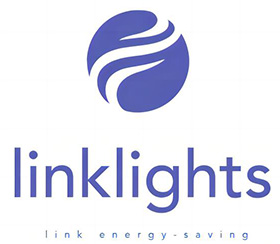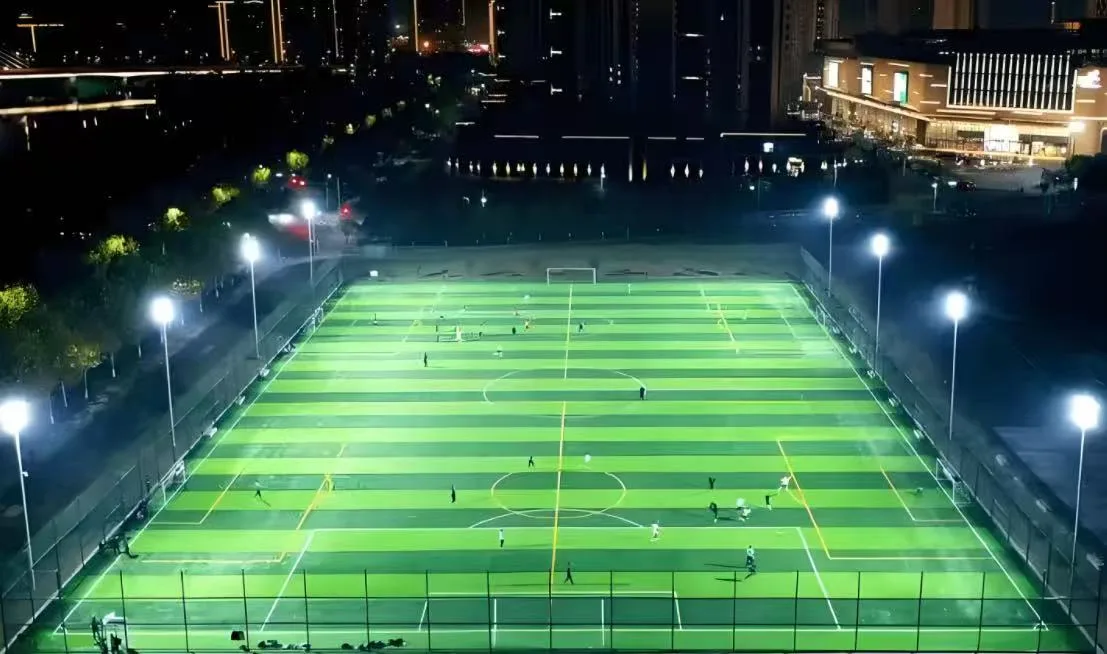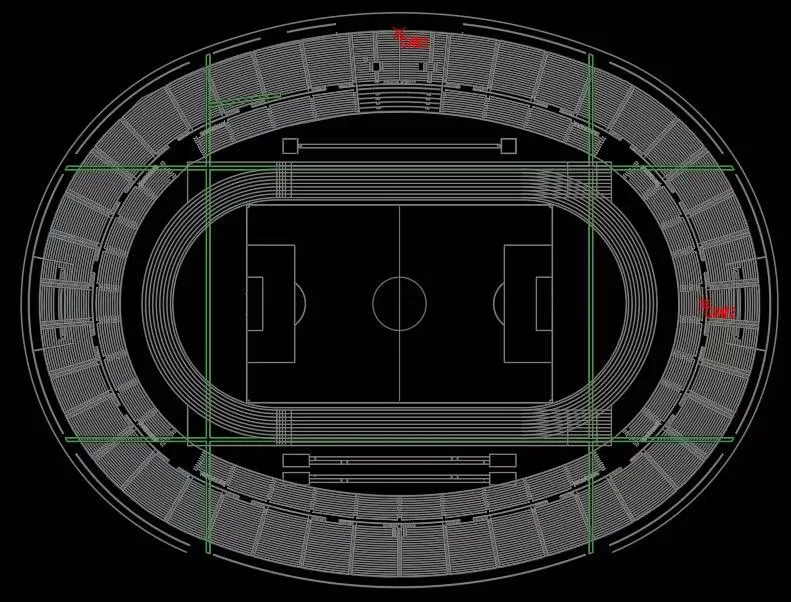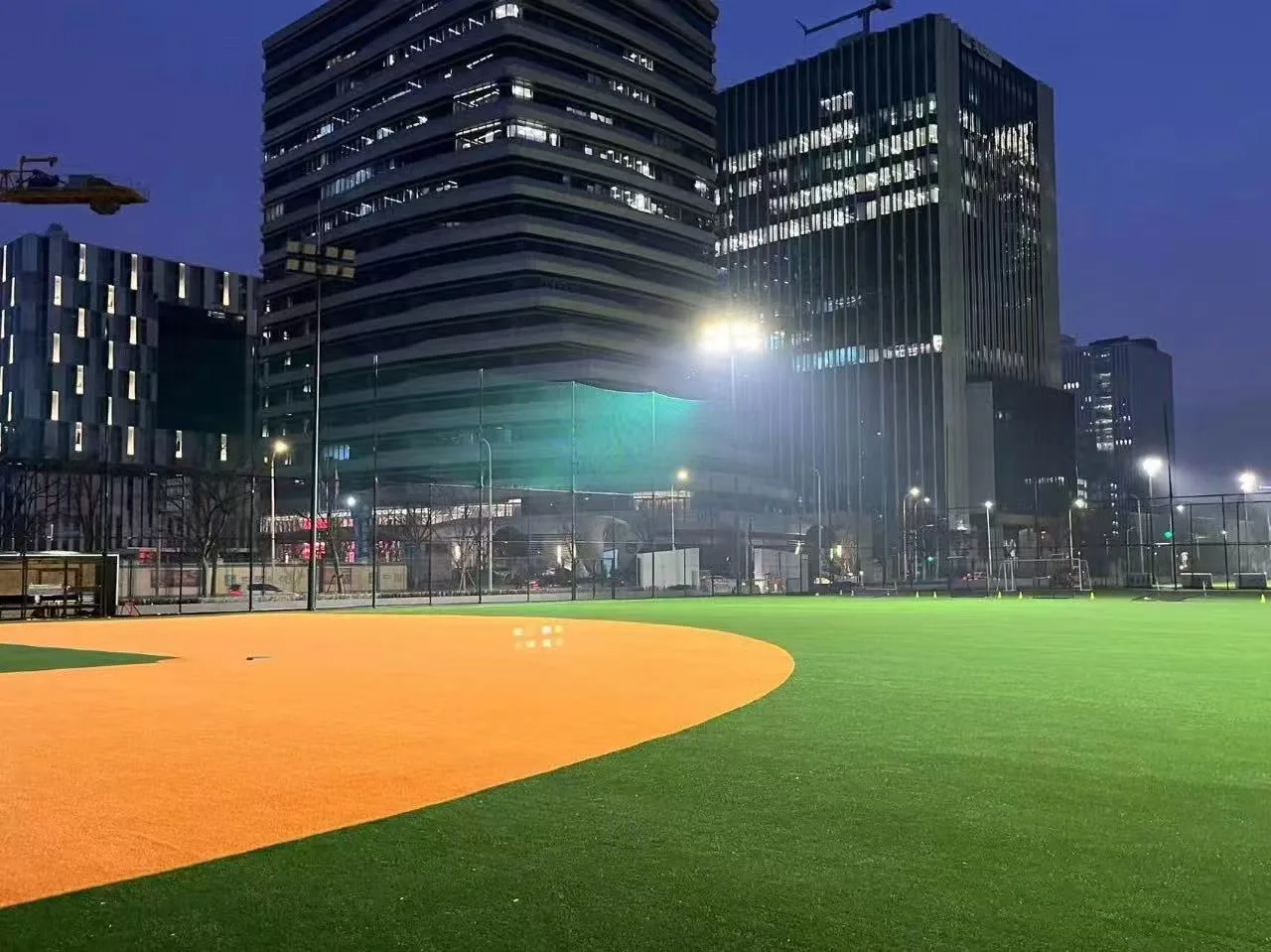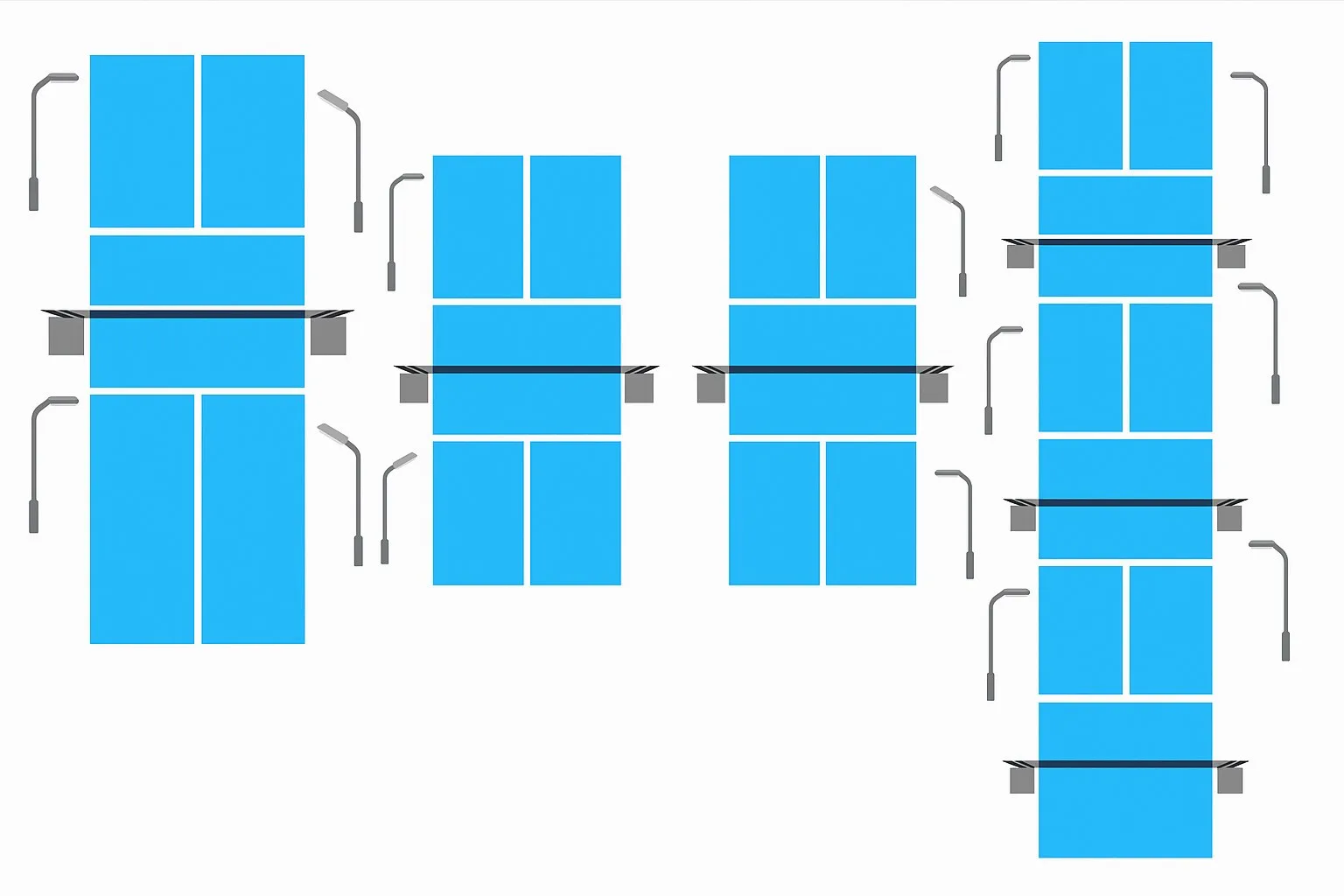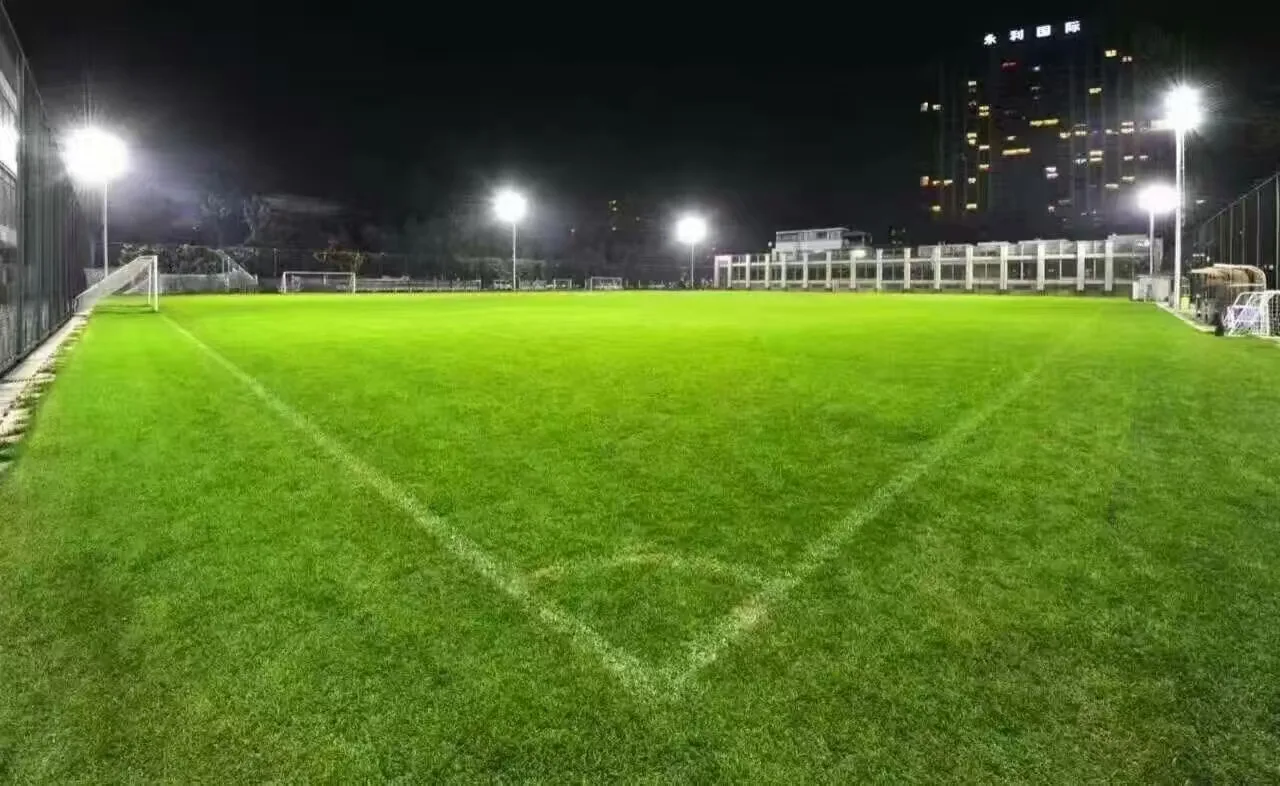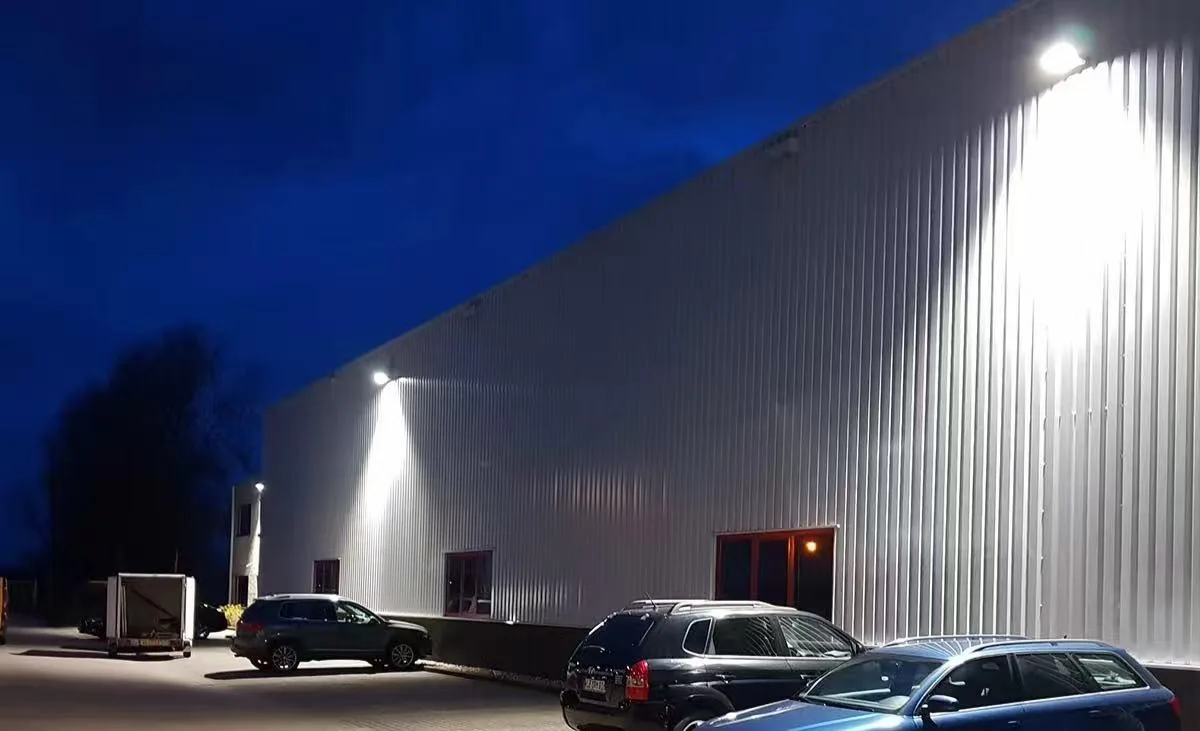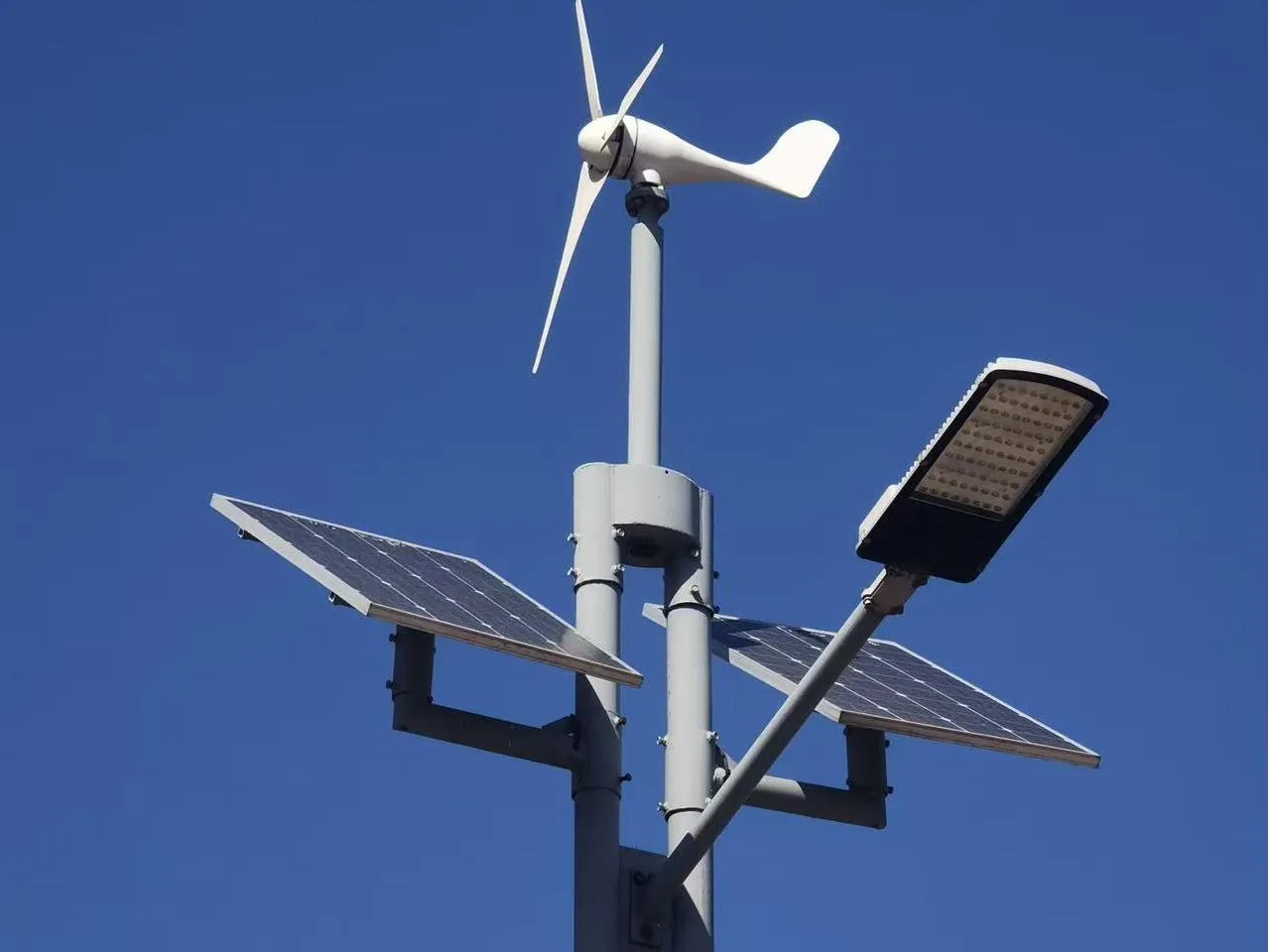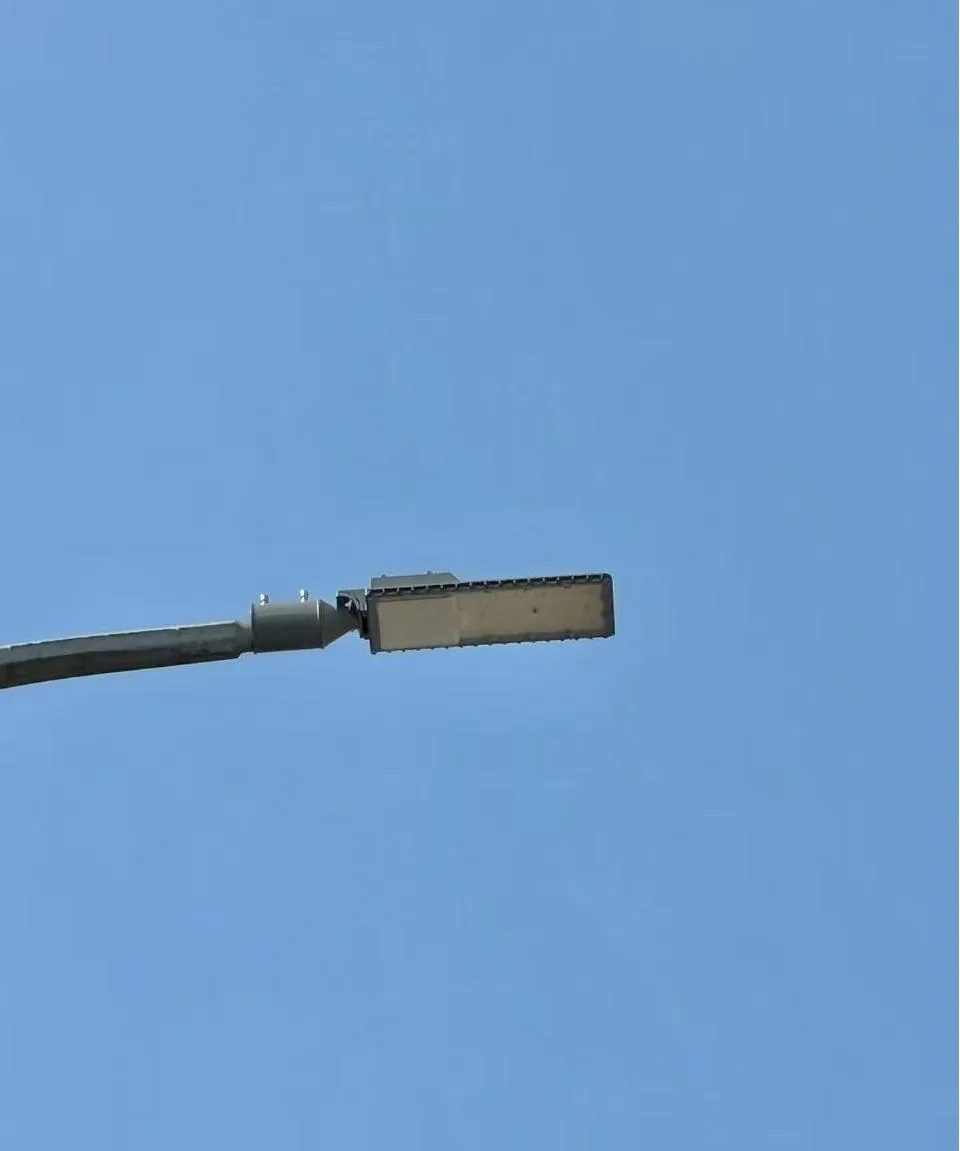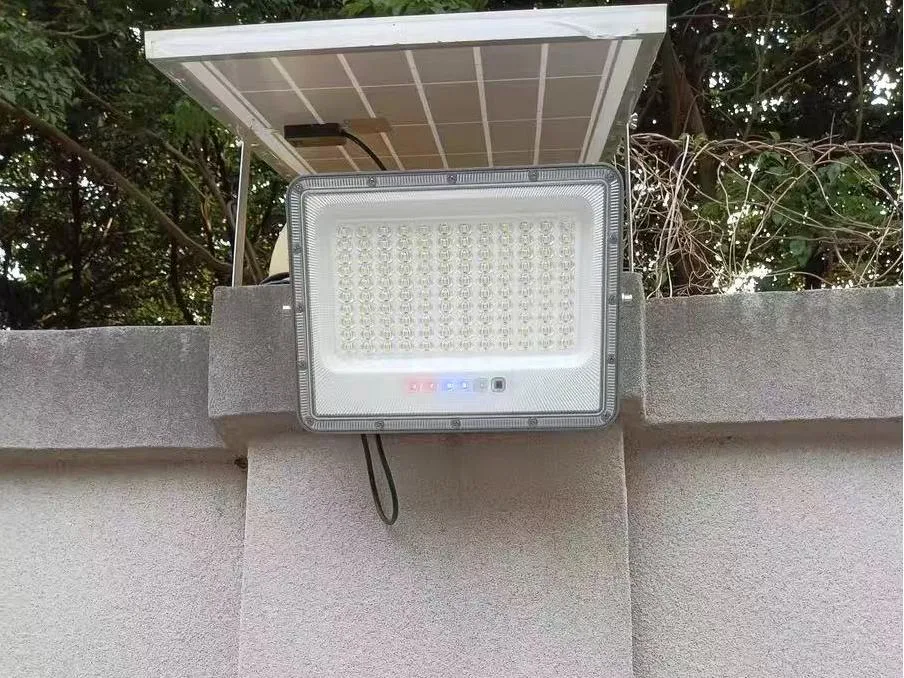Introduction — Why Lighting Design Matters in Modern Soccer
When the stadium lights come on, soccer becomes a show. Whether it’s a small weekend match or a global tournament, good football field lighting affects how players see, how safe the field feels, how well cameras record, and how much energy the stadium uses.
Old metal-halide lamps once lit most soccer fields. Today, led field lighting has replaced them with brighter, cooler, and more efficient systems. Modern lighted soccer fields show what true innovation looks like,But to get the best results, designers must understand what lights up a soccer stadium and how soccer field lighting can be controlled to meet safety and performance standards.
This guide explains what makes great led soccer field lighting. It looks at brightness (lux), beam angles, evenness (uniformity), glare control, and energy efficiency. It follows the latest FIFA 2023, EN 12193 (2022), and IES RP-6-20 rules so cities, clubs, and contractors can design safe, efficient, and professional-grade lighting systems.
Understanding Field Size and Lighting Classes
Standard soccer football pitch Dimensions
A FIFA soccer football field is usually 105 m long and 68 m wide. Smaller fields for high school soccer field size or training may be 90 × 45 m or even 60 × 40 m.
Lighting plans must also include:
A 2–3 m safety zone is kept around the main areas of football pitch to protect players and officials.
Spectator and camera areas
Perimeter zones that still need good visibility
Designers often plan for a total illuminated area of about 111 × 74 m
Lighting Classes and Brightness Levels
Different competitions need different lighting strengths. These are grouped into classes by the EN 12193 standard.
| Competition Type | Average Brightness (lux) | Uniformity (U₀) | Typical Use |
| Training / Recreation | 75 – 200 | ≥ 0.5 | Local fields, schools |
| Club / Amateur Matches | 200 – 500 | ≥ 0.6 | Small stadiums |
| Professional Matches | 800 – 1500 | ≥ 0.7 | League games |
| Broadcast / International | 2000 + | ≥ 0.8 | TV & 4K stadiums |
More brightness means more careful aiming and smoother beam overlap.
When a stadium field needs stronger light, each soccer led floodlight must be aimed with greater care so that their beams cover the whole field stadium evenly. This is called beam overlap — when one light’s edge blends softly into the next. Good overlap removes dark areas and avoids bright spots that can distract players or confuse TV cameras.
Higher lighting classes need better vertical light for cameras and less glare for people.
In big games or live broadcasts,soccer light must not only shine on the ground but also on upright surfaces — faces, shirts, and the moving ball. This helps cameras show clear and natural colors from every angle. At the same time, engineers use anti-glare lenses and shields to aim light downward and keep it out of the spectators’ eyes, making the view safer and more comfortable.
Key Lighting Terms and Why They Matter
Horizontal and Vertical Brightness
Horizontal brightness (Eh) is the light that falls on the ground — it’s what players see when they run, pass, or kick.
Vertical brightness (Ev) is the light that shines on upright things like faces, shirts, and goalposts.
TV cameras need strong vertical lighting to show clear, colorful pictures.
On broadcast fields, the vertical brightness should be about 70 to 90 percent of the horizontal level.
Uniformity (U₀)
Uniformity shows how evenly light spreads across the football stadium field.
It is calculated as Emin ÷ Eavg, which means the dimmest light level divided by the average brightness.
If the darkest area on the pitch has 700 lux and the average is 1200 lux, the result is U₀ = 0.58 — too low for professional play.
Poor uniformity creates bright and dark patches that make it hard for players to see the ball clearly or judge distance. It can also cause uneven exposure on camera.
Designers fix this by changing the aiming angle and beam overlap of each football light fixture until the uniformity value reaches U₀ ≥ 0.7, which gives smooth, balanced light across the whole field.
Glare and Comfort
Too much glare makes it hard for players to track the ball and react quickly.
It can also make spectators uncomfortable and cause cameras to lose focus or color detail.
In outdoor sports lighting for professional fields, the glare rating (GR) should stay below 50 to keep vision clear and safe for both players and viewers.
field lighting designers use asymmetric lenses, visors, and special beam angles to direct light toward the field and away from people’s eyes.
These tools control how light leaves each soccer light fixture, helping create bright, even illumination without the harsh shine that can spoil visibility or reduce broadcast quality.
Color and Flicker
Good outdoor field lighting should look like daylight on TV.
That means players, fans, and cameras all see true, natural colors.
The Color Rendering Index (CRI) shows how real colors appear under the lights.
A CRI of 80 or higher works well for most matches, while 90 or higher is best for professional games and live broadcasts.
The Color Temperature (CCT) should be between 5000 K and 5700 K, giving a bright, clean white light that matches natural daylight and helps cameras keep good contrast.
The Flicker Index must stay below 1 percent so slow-motion replays look smooth.
High-quality drivers in led sports field lighting control power more evenly, stopping the light from flickering or pulsing on screen.
When all three—CRI, CCT, and flicker—are set correctly, a soccer or football field looks bright, clear, and natural to both the human eye and broadcast cameras.
Optical Design and Beam Control
Beam Angles
Every led soccer projects its beam at a specific angle.
This angle controls how wide or narrow the light spreads across the field.
Narrow beams (15–30°): Used on tall poles or in large stadiums. They throw light farther, helping cover the center of the field without wasting light outside the play area.
Medium beams (40–60°): Common on mid-height poles for community or training fields. They give balanced side lighting and help remove shadows.
Wide beams (90–120°): Used near corners or short poles. They fill dark zones and improve brightness close to the sidelines.
Most arena lighting design use a mix of these beam angles.
Combining narrow, medium, and wide beams helps achieve even brightness (uniformity) and keeps glare low for both players and spectators.
Learn more in our [LED Flood Light Optics Guide].
Lens Material
| Lens Type | Light Passing Through | Main Benefit |
| PMMA (Acrylic) | 92–93 % | High clarity, precise focus |
| PC (Polycarbonate) | 88–90 % | Strong and impact-resistant |
Led lights for football field often use anti-UV coatings to prevent yellowing and keep light output steady over many years.
Pole Layout and Mounting Height
Common Configurations
| Layout | No. of Poles | Mount Height (m) | Use Case |
| 4-pole | 4 | 15–18 | Training or small fields |
| 6-pole | 6 | 18–24 | Community stadiums |
| 8-pole | 8 | 25–40 | Professional venues |
Poles should stand 10–15 m outside the sidelines for safety.
Each carries 3–6 soccer lights aimed to overlap beams and remove shadows.
Aiming Tips
Aim beams below 60° from horizontal to limit glare.
Overlap edges by 10–20 % for even coverage.
Add camera-side lighting to raise vertical brightness.
Simulation software like Dialux or AGi32 helps check these settings before installation.
Meeting International Standards
EN 12193 (Europe)
Divides lighting into three classes based on ies lighting levels.
Also limits glare (GR < 50) and sets rules for color quality (CRI ≥ 80) and flicker control.
IES RP-6 (North America)
Gives ratios for horizontal / vertical lighting and recommends flicker level Pst LM ≤ 1.
Gives ratios for horizontal and vertical lighting and follows ies lighting level recommendations, including a suggested flicker limit of Pst LM ≤ 1.
FIFA Stadium Lighting Guide
The FIFA Stadium Lighting Guide explains the key led lighting standards for stadiums.
covering brightness, uniformity, color, and flicker control for professional play.
For world tournaments, FIFA requires average brightness of ≥ 2000 lux, uniformity of ≥ 0.8, and color temperature between 5000 K and 5700 K to meet broadcast-quality lighting levels.
| Level | Horizontal lux | Vertical lux | Uniformity U₀ | CRI |
| Training | 200 | 75 | ≥ 0.5 | ≥ 70 |
| Club Play | 500 | 250 | ≥ 0.6 | ≥ 80 |
| Broadcast | 1000 – 2000 | 800 + | ≥ 0.8 | ≥ 90 |
See our [Sports Lighting Standards Comparison Chart].
How to Read Lighting Data
Each led field light comes with a photometric file (known as an IES or LDT file).
This file shows how light spreads from the fixture and helps designers test whether the system meets ies standards for lighting before installation.
Key items to check include:
Luminous Intensity Chart: Shows the beam shape and how strong the light is in different directions. It helps engineers decide which fixture angle gives the best coverage for a soccer or football field.
Isolux Diagram: Displays light levels (lux) across the playing surface. It reveals bright and dark zones so designers can adjust pole height or beam overlap to get even illumination.
Cross Section: Compares brightness between the sidelines, goal areas, and center. This ensures that players experience equal visibility everywhere on the pitch.
Aiming Table: Lists the exact tilt and rotation for each soccer led light. This guarantees that lights are aimed consistently and that the final setup matches the design plan.
To confirm compliance with lighting standards:
The average brightness (Eavg) must meet or exceed the target lux level.
The uniformity ratio (Emin / Eavg) must be equal to or higher than the required U₀ value.
Avoid hot spots, where the maximum light level is more than 1.5 times the average.
Keep glare (GR) below 50 to protect players’ eyes and improve spectator comfort.
These checks help ensure that stadium or field lighting provides clear visibility, balanced light, and comfort for both live play and TV broadcasts.
Learn more in our [Sports Photometric Design Guide].
Choosing the Right Soccer LED System
Performance Checklist
| Feature | Target Value | Why It Matters |
| Luminous Efficacy | 150–180 lm/W | More light, less power |
| Driver Power Factor | > 0.95 | Stable current draw |
| Surge Protection | 10–20 kV | Handles voltage spikes |
| Thermal Design | ADC12 aluminum body | Keeps LEDs cool |
| IP / IK Rating | IP66 / IK10 | Weather & impact proof |
| Lifetime | L90 > 100,000 h | Low maintenance |
| Smart Control | DALI / DMX | Dimming & scheduling |
High-quality LEDs should use high-frequency drivers to remove flicker and include smart controls for energy saving.
Explore our [LED Stadium Flood Light Series] for examples.
Energy and Cost Savings
Lighting can use up to 60 % of a stadium’s power at night. LEDs cut that by half or more.
Energy Example
| System | Fixtures | Power Each (W) | Total (kW) | Yearly Use (kWh) | Cost @ $0.15 /kWh |
| Metal Halide | 32 | 2000 | 64 | 64,000 | $9,600 |
| LED Flood | 24 | 1200 | 28.8 | 28,800 | $4,320 |
→ Energy Saved: 55 % | Payback: ~ 2.8 years
LEDs also cut CO₂ emissions by ~40 tons per field each year and need almost no bulb replacements.
Maintenance
Modern LEDs rated L90 > 100,000 h can last 15–20 years.
Modular fixtures allow single-unit repairs, saving time and cost.
Check our [Sports Lighting ROI Calculator] to estimate your savings.
Case Study — City Training Field Retrofit
Location: Northern Europe, 2024
Goal: Replace 32 × 1500 W metal-halide with 24 × 1000 W LEDs
Layout: 6 poles × 18 m, Class II (Club level)
Results:
Average brightness = 312 lux
Uniformity U₀ = 0.63
Glare rating = 48
Energy reduction = 57 %
CO₂ cut = 38 tons per year
Payback = 2.9 years
Players reported clearer ball tracking and fewer shadows. The city plans to expand LEDs to all municipal sports fields next year.
Best Practices for Designers
Best Practices for Lighting Designers
Define the competition class early — don’t overspec.
Decide whether the field is for training, amateur games, or professional matches. Each class has its own lux and uniformity targets. Designing too high wastes energy and money; too low fails safety and visibility tests.
Always use verified IES or LDT files in design software.
These files show the real light output of each LED fixture. Using accurate data ensures that the simulation matches how the field will actually look once installed.
Match beam angles to pole height.
Narrow beams work best on tall poles for long-distance coverage, while wide beams suit shorter poles and corner areas. The right combination avoids dark spots and glare.
Plan for vertical lux if video or TV is required.
Broadcast lighting must show players’ faces, numbers, and the ball clearly. Adding vertical illuminance helps cameras capture natural, balanced images.
Keep power factor above 0.95 and THD below 10%.
A high power factor means efficient energy use, while low harmonic distortion (THD) prevents flicker and protects other electrical systems in the stadium.
Wire for smart controls (DALI or DMX) even if not used now.
Installing control cables during construction makes it easy to add dimming or scene control later — for example, lowering brightness during training to save power.
Test the installed system with calibrated lux meters.
Field tests confirm that the real brightness and uniformity match the design plan. Measuring after installation ensures compliance with FIFA, EN, or IES standards.
Find templates in our [Sports Lighting Design Handbook].
FAQ
Q1: What brightness do soccer fields need?
→ 75 – 200 lux for training, 200 – 500 lux for clubs, 800 – 1500 lux for professional games, 2000 + for broadcasts.
Q2: How many poles for one field?
→ Usually 6 to 8 depending on size and broadcast needs.
Q3: Which beam angle is best?
→ 20–30° for tall poles, 40–60° for mid-height, 90° for short training setups.
Q4: What color temperature works best?
→ 5000 – 5700 K for a daylight look and clear TV footage.
Q5: How to keep light even?
→ Overlap beams 10–20 %, aim symmetrically, and use optics with Type III or IV distribution.
Q6: Are LEDs flicker-free?
→ Yes. High-frequency drivers remove visible flicker (< 1 %) for HD and 4K broadcasts.
Conclusion — Bright, Safe, and Sustainable Fields
Modern soccer lighting is both science and design. Meeting FIFA, EN 12193, and IES RP-6 standards ensures players see clearly, spectators enjoy the game, and energy use stays low.
LED systems bring:
Up to 70 % energy savings
Stable color and instant on/off
Long life and low maintenance
Whether you’re upgrading a local field or building a world-class arena, good lighting design delivers safer play, sharper images, and sustainable performance for years.
For custom field layouts or professional design help, contact our engineering team or explore our [Soccer LED Lighting Solutions].
